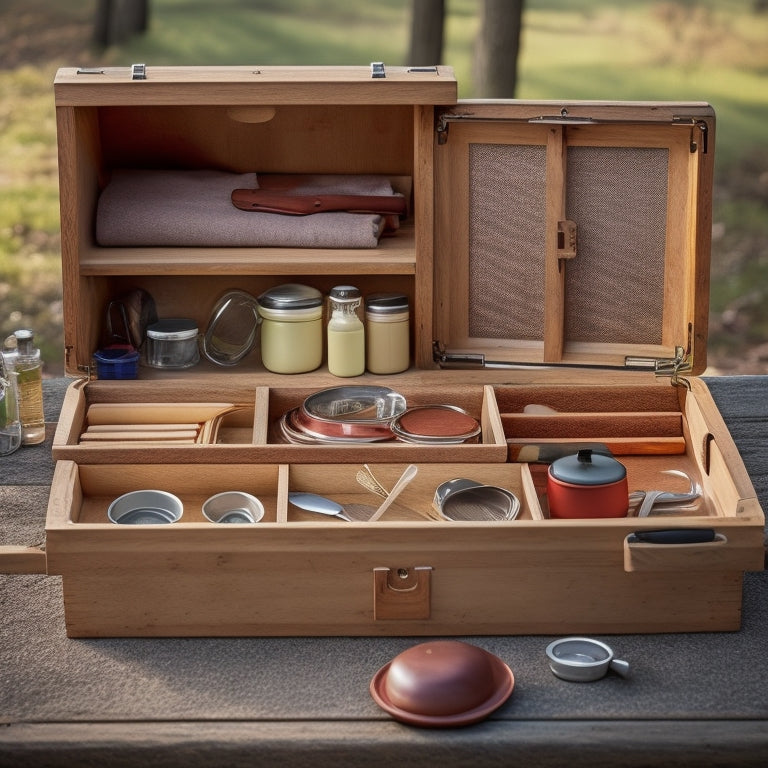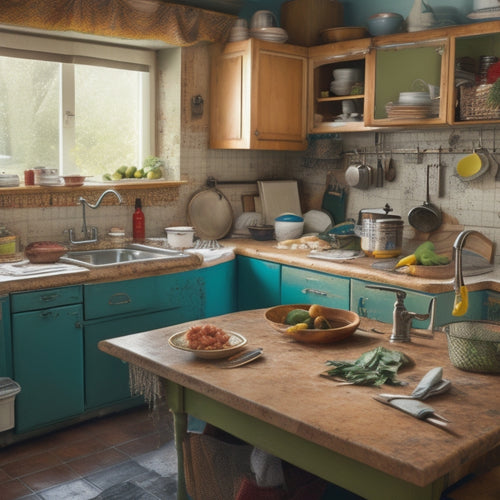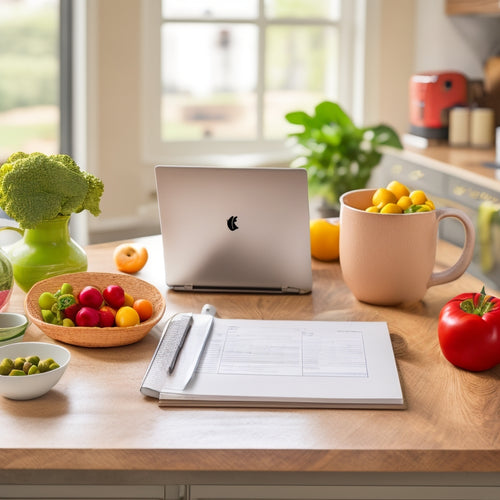
Crafting the Ultimate Camp Kitchen Organization Box
Share
I've spent countless hours refining my camp kitchen setup, and I've learned that a well-organized chuck box is the key to a stress-free outdoor cooking experience. To craft the ultimate camp kitchen organization box, I prioritize a compact yet functional layout, accommodating my camp stove and propane bottle. I add finishing touches like a lid, hinges, and latches, ensuring secure storage and easy transport. With careful planning, I optimize every inch, assigning designated spots for each item and utilizing vertical space. By following my blueprint, you can create a customized camp kitchen box that streamlines your outdoor cooking adventure, and there's more to explore in making it truly exceptional.
Key Takeaways
• Design a compact yet functional layout with shelves and compartments to maximize storage and accessibility in your camp kitchen box.
• Prioritize long-lastingness and safety in construction, using materials like plywood and Spar polyurethane finish for outdoor resilience.
• Assign designated spots for each item, categorizing gear into frequently and less frequently used items to save time and reduce frustration.
• Utilize vertical space with hooks, baskets, or shelves to optimize storage and keep heavy items low for easy access.
• Ensure weight distribution for balance and stability, and add handles for easy transportation of your camp kitchen box.
Building the Perfect Box
As I begin constructing my camp kitchen chuck box, I measure the dimensions of my camp stove and gear to secure a snug fit. This secures a custom design that accommodates all my essential cooking equipment.
With portable options in mind, I opt for a compact yet functional layout. I carefully lay out the measurements on a plywood sheet, taking into account the space needed for shelves, compartments, and other features.
I assemble the sides, back, and bottom of the box, securing a sturdy foundation for my camp kitchen. With a solid base, I can now focus on adding the finishing touches, including the lid, hinges, and latches.
Tips and Essential Modifications
I consider necessary adjustments to make certain my camp kitchen chuck box meets my specific needs, starting with accommodating my camp stove type and propane bottle usage.
I also address hinge and latch screw protrusion issues to guarantee a smooth operation.
A clear spar urethane finish provides outdoor durability, while adding handles makes transportation a breeze.
Customization options, such as modifying the design to fit my personal preferences, are essential.
User feedback is invaluable in identifying areas for improvement and suggesting new features.
By incorporating these tips and modifications, I can create a camp kitchen chuck box that not only looks great but also functions flawlessly.
With these tweaks, I can enjoy a more efficient and enjoyable camping experience.
Key Features and Specifications
My camp kitchen chuck box boasts a range of innovative features, including a lid that can be adjusted to hold at various angles and supports, making food preparation and storage a breeze. The lid's weight, around 10-15 pounds, is substantial enough to provide stability without being too cumbersome.
The box itself weighs approximately 47 pounds empty, but the filled weight can vary significantly depending on the gear and supplies I choose to carry. To guarantee portability, I've incorporated customization options, such as handles, to make transportation easier.
Additionally, I've considered weight distribution to ensure the box remains balanced and stable, even when fully loaded. With these features, I can focus on cooking up a storm in the great outdoors.
Construction and Safety Considerations
Forty construction screws are strategically driven into the plywood to guarantee strength, omitting the need for fence face pieces that can compromise the box's structural integrity.
As I build my camp kitchen organization box, I prioritize construction tips that ensure long-lastingness and safety. I adjust shelf spacing to accommodate specific items, considering the stove space and ergonomic access.
Finishing with Spar polyurethane provides outdoor resilience, while handle placement and screw concealment enhance aesthetics.
Wildlife safety is also essential; I design the box with secure latches and a tamper-evident seal to prevent curious critters from rummaging through my gear.
Optimizing Your Camp Kitchen
With a sturdy and secure camp kitchen organization box in place, optimizing your camp kitchen's layout and workflow becomes the next key step in ensuring a seamless outdoor cooking experience. Now, it's time to fine-tune my storage solutions and organization hacks to maximize efficiency.
I'll start by categorizing my gear into frequently used and less frequently used items, then assign a designated spot for each. This will enable me to quickly find what I need, saving time and reducing frustration.
Here are my top optimization strategies:
-
Designate zones: Assign specific areas for food prep, cooking, and cleaning.
-
Utilize vertical space: Install hooks, baskets, or shelves to store items like utensils, spices, and cookware.
-
Implement a 'one-touch' rule: Store items in their designated spot as soon as I'm done using them.
- Keep heavy items low: Store heavy cookware and appliances at the bottom of my camp kitchen box for easy access and stability.
Frequently Asked Questions
Can I Use a Pre-Made Cabinet or Shelving Unit Instead of Building?
'I weigh the pros and cons of buying a pre-made cabinet versus DIYing; considering design layouts and space constraints, I opt for a custom build to guarantee a perfect fit for my camp kitchen needs.'
How Do I Secure the Box to the Campsite or Vehicle During Transport?
"As I hit the open road, I'm anchored down by the thought of my camp kitchen box flying away - that's why I'm securing it with a robust locking mechanism, anchor points, and weatherproofing, while also incorporating anti-theft measures to safeguard my culinary castle."
Are There Any Specific Camping Regulations I Should Consider When Building?
When building my camp kitchen box, I make sure I'm aware of campsite restrictions and regulations to follow, considering safety and using building materials that meet local guidelines, to avoid any issues during my camping trip.
Can I Add Electrical Components, Like Lights or Outlets, to the Box?
"Oh, the temptation to add electrical components is strong, but I must prioritize electrical safety and functionality over design aesthetics and practicality - a single misstep could ruin my camping trip!"
How Do I Clean and Maintain the Box After Repeated Camping Trips?
After each camping trip, I thoroughly clean my kitchen box with soap and water, then dry it to prevent moisture buildup; for maintenance, I store it in a dry place and apply a waterproof sealant to guarantee long-term care.
Related Posts
-

Why Kitchen Renovation Demands a Meal Planning Strategy
As you prep for your kitchen renovation, you'll quickly realize that the absence of a meal planning strategy is a rec...
-

Free Low-Carb Meal Planning Templates for Easy Success
You're about to discover the secret to effortless low-carb meal planning: leveraging free, customizable templates tha...

